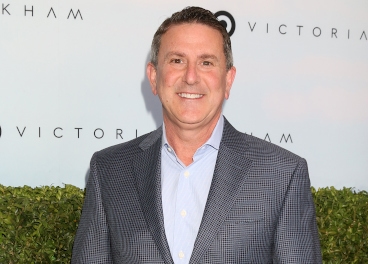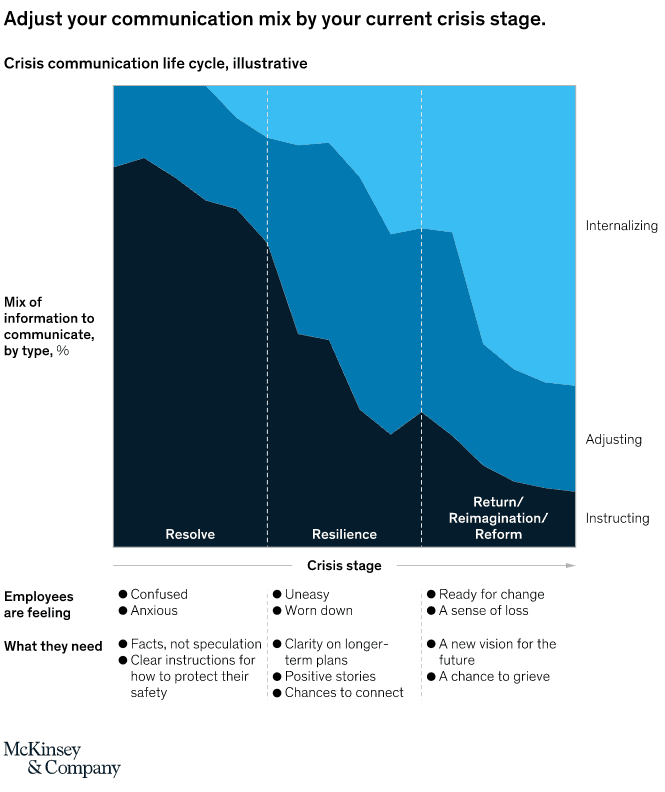Caption: Rt Hon Jacinda Ardern, Prime Minister of New Zealand, is globally-recognized for her exceptional communication skills
Executive communications is a core leadership function.
Done well, a leader can inspire and motivate their team, creating a genuine sense of togetherness.
Done poorly, staff can feel isolated and confused, breeding a culture of uncertainty.
Nobody enjoys delivering bad news. But it’s precisely these times that people are seeking maximum information that’s honest, accurate and explanatory.
Executives who shy away from these tough conversations stand the risk of alienating themselves and losing their employees’ respect. In the absence of information, people may turn to hearsay or assume their own conclusions. That’s when wrong information can quickly spread, causing fear and anxiety. Getting the internal communications right has to be a priority.
So, as business leaders steer their company through potentially one of the worst economic crises in living memory, we offer some best practice tips on executive communications during difficult times.
Executive Communications In A Crisis
Employee appetite for regular trusted information from employers during COVID-19 is high. In one study, some 63 percent asked for daily updates and 20 percent wanted communications several times a day.
Gallup also recently undertook a survey of 100 members of Chief Human Resource Officers which stated CEOs and leaders are communicating more frequently than ever before. Most are providing weekly and even daily updates and guidance, and rethinking how they communicate: a steady cadence and repeated messages frequently helps improve message retention.
Alongside expert advice, these communications often include a personal element. The pandemic has resulted almost overnight in a wholesale move to remote working. Many are now finding new ways to make genuine connections with staff.
Providing credible and reliable information to employees has been essential during the crisis. Effective messaging from leaders that references credible news sources such as the World Health Organization will help build trust. According to Gallup, corporate leaders are also providing inspirational and motivational messages to ensure the workforce stays positive.
The research reported executives are using various channels and are tailoring their communications more to the recipient. Social media, SMS texts, email, hotlines, and internal platforms such as the intranet are some of the channels used.
Best Practice Tips For Executive Communications
The coronavirus crisis has undoubtedly brought into sharp focus the need for decisive and honest communications. So, what can executives do to garner support from staff and improve their communications?
Be Authentic
Staff value authentic and transparent messaging. Real and personal communications are more engaging and are a better way to get your message across. And they are also a valuable tool in building relationships based on trust.
One platform for delivering authentic messages is an intranet-based CEO blog. Richard Branson and Mark Zuckerberg are great examples of how to do it. Both have developed their own style and tone of voice. They use blogs to reflect on personal issues, which provide an insight into the real person rather than the CEO. Zuckerberg’s deeply personal A Letter To Our Daughter has been liked by 1.6 million people worldwide and has been shared 300,000 times.
Your blog may not have the reach of Zuckerberg’s. However, a similarly authentic message could be just as impactful with your audience.
And in the context of distributed teams, short video messages have a vital role to play. Video allows you to deliver in-person messages even though staff are working from home. And the recording capabilities of today’s smartphones have made video a cost-effective and accessible medium.
As well as recorded messages, why not set up a social media live stream? Use it to engage directly with staff in a question-and-answer session. And upload it afterward to the intranet’s newsfeed for maximum coverage.
To break down barriers, why not record videos of executive or board meetings, be they virtual or in the boardroom? Employees don’t usually get to see what goes on at these meetings, and will appreciate the exposure that goes into decision-making. Video highlights give workers a peek into the lives and personalities of C-suite executives.
Evolve Your Communications
Every crisis has a life cycle, made up of different stages. McKinsey & Company has identified five stages of the Covid-19 crisis: resolve, resilience, return, reimagination, and reform. Employees will be feeling a range of emotions during each stage. It is the executive’s job to sensitively adjust their communications accordingly. In other words, ‘give people what they need, when they need it’, as per the illustration below:
Use A Variety Of Communications Channels
Most digital workplaces nowadays use a range of communications channels to satisfy the preferences of different workers. CEO communications should look to deliver timely and consistent messages across these channels. Utilize all platforms, including the more traditional emails and printed newsletters, through to intranets and instant messaging.
An all-encompassing approach to communications ensures maximum staff coverage. Employees will receive the same timely, consistent messages, including remote workers and those in non-desk roles.
And it’s essential to allow for two-way conversations. Top-down approaches to executive communications are not enough. The modern workplace requires multi-directional channels that also enable staff to feedback directly to executives.
Universal coverage and transparency are even more critical in the context of change management. Honest, consistent, and on-point communications are essential during the tough times unleashed by the pandemic. A #changemanagement channel on the team chat, for example, is one way to connect directly with staff. You can use the channel to tackle head-on any rumors and respond to misinformation. In turn, employees can ask questions and raise concerns to corporate leaders.
Measure The Impact Of CEO Communications
Just as you would measure the success of any corporate initiative, so the impact of CEO communications needs to be monitored. Leaders must be able to prove the return on investment for executive communications.
Ideally, you should collect a range of metrics and KPIs to track progress. Productivity measures, employee engagement, staff turnover and retention, customer satisfaction, and sales are all relevant indicators. Make sure you also collect feedback from staff on the effectiveness of executive communications. Whether it’s employee pulse surveys, intranet snap polls or focus groups, it’s vital to listen to the workforce’s views. Consider asking employees the following questions:
- What are the best communications channels to get information across?
- Are executive communications clear and open?
- Do CEO communications satisfy your information needs?
- Do executive communications keep you adequately informed and involved?
- How could CEO communications be improved?
Furthermore, it’s worthwhile to collect statistics on specific communications channels. Include data on readership, open and click-through rates, and qualitative feedback from staff to build an overall picture. A data-driven approach to CEO communications ensures you identify content and channels that resonate the most with employees. And perhaps just as importantly, it will help you avoid ineffective executive communications.
Best Practice Examples Of Leadership Communications
To inspire and motivate, we share below some real examples of executive communication at its best. These leaders share several characteristics that set them apart: authenticity, honesty, and an innate ability to connect with people.
Jacinda Ardern, Prime Minister of New Zealand
Jacinda Ardern (pictured at the top of this post) has won widespread praise for her style of executive communications during tough situations. Her deep sense of empathy and compassion for those affected by the 2019 Christchurch terror attacks was admired worldwide.
More recently, throughout Covid-19, Prime Minister Ardern has used appropriate language and communication techniques to engage her audience. In sports-obsessed New Zealand, her policy of ‘go hard, go early’ clearly resonated with Kiwis. Furthermore, at the height of the crisis, she made herself accessible by appearing at daily news conferences. During New Zealand’s 6-week lockdown, it became a ritual for many New Zealanders to tune into the 1pm daily briefings.
Ardern used this platform to reinforce the same consistent messages. Time and again, she referred to the nation as being ‘a team of five million.’ And she encouraged Kiwis to ‘be strong, be kind, and unite.’ There’s no doubt that Jacinda Ardern’s approach to executive communications has won the hearts and minds of her fellow New Zealanders.
Brian Cornell, Target CEO
Another excellent example of effective executive communications in action is that of Brian Cornell. Empathetic and authentic in his approach, the Target CEO has successfully aligned both internal and external messaging during the pandemic.

In a subsequent update on how we’re supporting our guests and team, the ‘mixternal’ approach continues. Cornell outlines additional steps the company is taking to keep customers and staff safe. He reports that employees have been offered extra benefits, such as paid illness and family leave plus free counseling.
By successfully aligning the internal and external message, Cornell has deftly increased the brand’s reputation. The carefully chosen, empathetic language builds trust with internal and external stakeholders alike.
Executive Communications: Key Messages
The coronavirus pandemic has highlighted the importance of executive communications. Honest, consistent, and regular messaging is what’s required in these difficult times. Staff need the reassurance and support of C-suite executives now more than ever. Therefore, be real and authentic in your communications. Above all else, make yourself highly visible.
Employees will reflect what they see and hear from executives in their communications with customers and stakeholders. And so it’s essential to get it right. It could be the crucial factor that sees your business survive and thrive in the post-Covid world.
Achieving success in executive communications requires a thoughtful approach to employee lifecycle and crisis management. Evaluating best practices for channels, content, and timing helps executives make the most of their communication efforts. As you consider your executive communications strategy, think about how it can support employee engagement, employee retention, employee productivity and employee morale. The goal should be to create an environment that fosters strong relationships between leaders and employees within the organization. Executives who are well-versed in effective communication are sure to have tremendous success down the road.
To support executive communications, MyHub offers all-in-one intranet software. This incorporates a set of integrated tools designed to deliver important executive communications, including: news feeds, blogs, discussion forums, instant messaging, and employee surveys. Find out more about a free 14-day trial today, or request a free demo from one of our design experts.








0 Comments